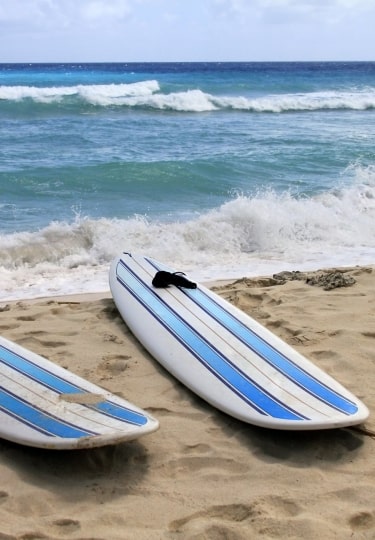It may not come as a surprise that there are some incredible places to go surfing in the Caribbean. After all, the region is known for its tropical temperatures, sandy beaches, and warm, clear water.
On many islands, it’s easy to get on a board, even if you only have a few hours to spare. Many of the best places for surfing in the Caribbean are suitable for beginners, sometimes in water no more than three or four feet deep. Most surf schools can teach you the basics in under half an hour.
Ride the waves at one of these islands with the best surfing in the Caribbean.
Barbados
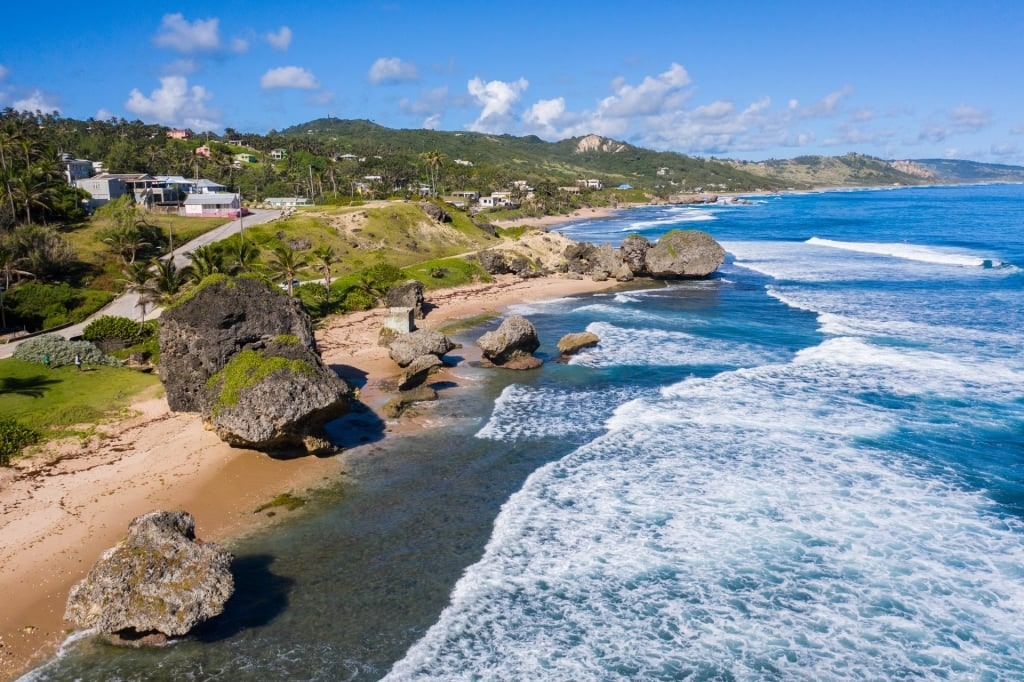
Bathsheba Beach, Barbados
Barbados is perhaps best known for its relaxed blend of English-meets-Caribbean atmosphere. There’s plenty to do in Barbados, from trekking tours through the dark, waterlogged caverns of Harrison’s Cave to searching for the green monkey. But if you’re into watersports, head to Bathsheba Beach. Surfers the world over know that it’s one of the best places for surfing in the Caribbean.
Bathsheba Beach is perfect for experienced surfers, or at least surfers who don’t mind learning on big waves. There are a few dozen surf breaks here, the most famous of which is called the Soup Bowl. If you show up and the waves look too intimidating, you can grab a cold drink and a snack from a nearby vendor, find a spot on the sand, and watch the experts make surfing look easy.
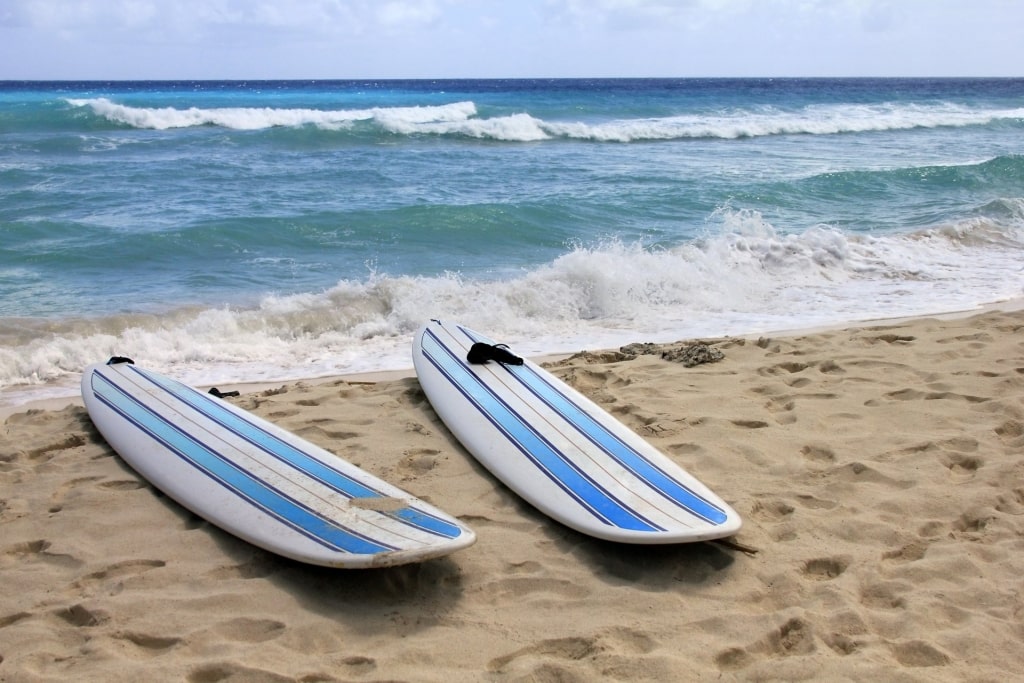
Dover Beach, Barbados
If you’re looking for calmer waters, head instead to Dover Beach, one of the best places for beginners to surf in the Caribbean. You’ll find more than a few highly regarded surf schools, offering beginner and intermediate lessons as well as surfboard rentals.
The waves here can be as low as two feet or as high as six, so if you’re worried about finding the tiniest waves possible to learn on, book a lesson. That way, the school can drive you to the best spots to learn how to surf depending on that day’s wind and ocean conditions.
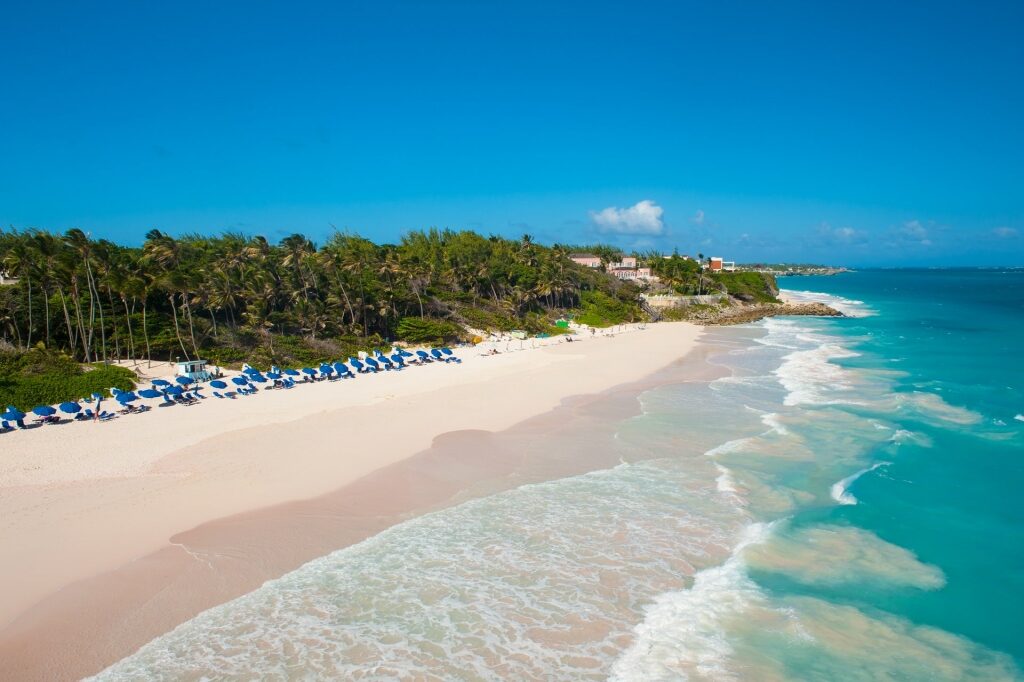
Crane Beach, Barbados
A final option for surfing on the island is Crane Beach, one of the best beaches in Barbados. The swells are best in the summer and early fall, but the current can be strong, so it’s best for strong swimmers and experienced surfers. If you get there and the current is too strong for much beyond boogie boarding, just walk to nearby Foul Bay Beach or grab a beachside cocktail at the nearby resort.
St. Kitts
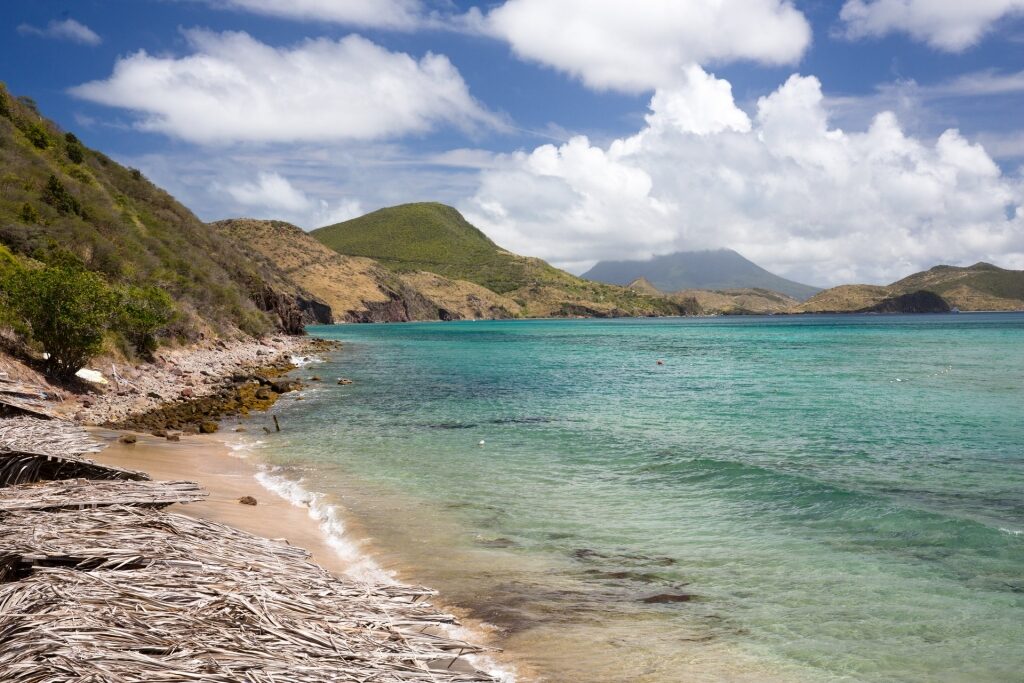
Frigate Bay, St. Kitts
It’s hard to find an island more beautiful than St. Kitts, with its lush scenery, perfect beaches, and an imposing volcano that dominates the landscape. Surfers who visit this island paradise generally head to Frigate Bay.
The waves are usually in the two- to four-foot range with gentle winds, making it an excellent spot for beginner surfers. Both the north and south sections of the beach have plenty of rental shops and guide companies, so it’s easy to check the surf reports outside the shops to get a sense of the waves that day. You’ll have your choice of surf lessons, from hour-long classes to all-day one-on-one lessons.

St. Kitts
Once you’ve worked up an appetite during your surf lesson, head to the southern end of Frigate Bay, where you’ll find dozens of the island’s best restaurants and bars. One of the best things to do in St. Kitts is to spend a whole day here, snorkeling or surfing in the morning, relaxing on the beach in the afternoon, and spending the evening watching the sunset from a beach bar.
St. Maarten

Maho Beach, St. Maarten
If you’re a surfer bound for St. Maarten, spend a morning or two catching a wave at Maho Beach. The beach is most famous for being next to the island’s airport, which means enormous jets fly very close to the beach. In fact, there’s no place in the world where you can stand closer to landing planes, and “skywatchers” have become a considerable part of the beach’s traffic.

Mullet Bay Pond, St. Maarten
The beaches on the west side of this island, including Maho Beach, have waves a bit too large for beginners. However, if you have someone in your group who is a knowledgeable surfer, the rest of the group will have plenty to do. Non-surfers can spend the afternoon at one of the beach bars or walk over to the calm waters of Mullet Bay Pond.
St. Maarten has some of the best surfing in the Caribbean for new surfers, too. Plum Bay is great for beginners, and Galion Beach has different surf breaks for beginners and experts alike.
If you head to Galion, try to spend the whole day there. Some of the best things to do in St. Maarten include taking surfing or windsurfing lessons, walking through the colorful La Ferme des Papillons (Butterfly Farm), visiting the natural history museum in the Old House, or heading out on a boat tour from sandy Orient Beach.
Tortola, British Virgin Islands
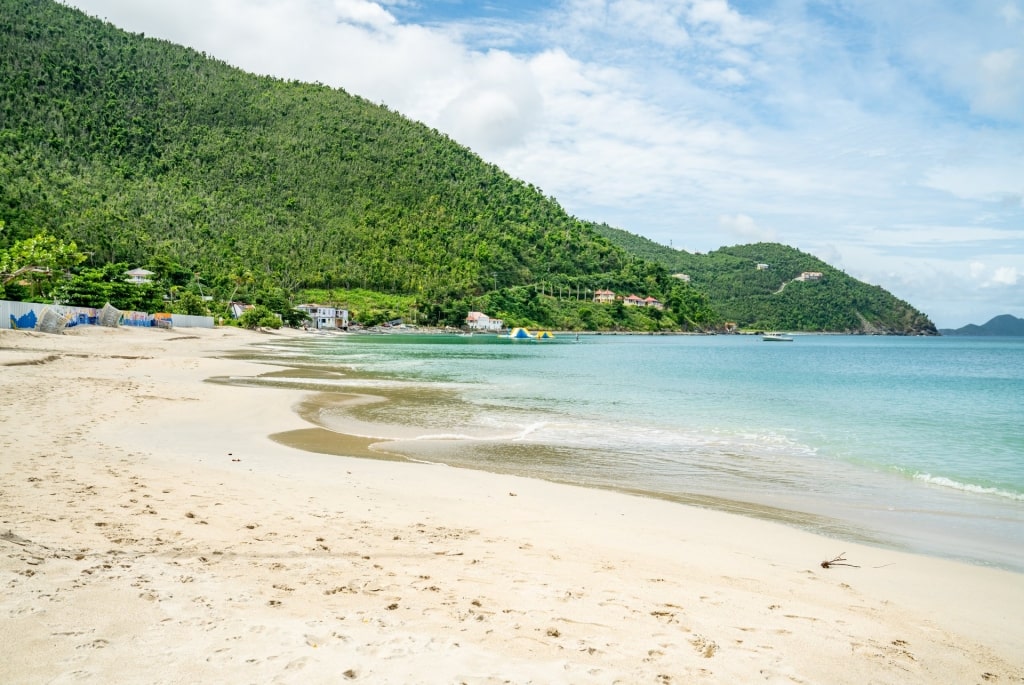
Cane Garden Bay, Tortola
Ready to hang ten in the British Virgin Islands? If so, head to one of the best beaches for surfing in the Caribbean, Cane Garden Bay. It’s one of the island’s busiest beaches, probably because it offers such a wide variety of activities like kayaking, snorkeling, boat tours, and surfing.
The waves here are largest in December, so if you’re visiting any other time of year, expect small swells—it’s a great place for beginners to dip their toes in the water. Waves are usually no more than a few feet high, the water’s warm, and the shallow bottom is soft and sandy.
When you’re ready to celebrate your newfound surf skills, you’ll have plenty of nearby options. Take it easy on the beach with a beach chair and umbrella rental, or head to the nearby Callwood Rum Distillery to taste island-made rum.
Aruba
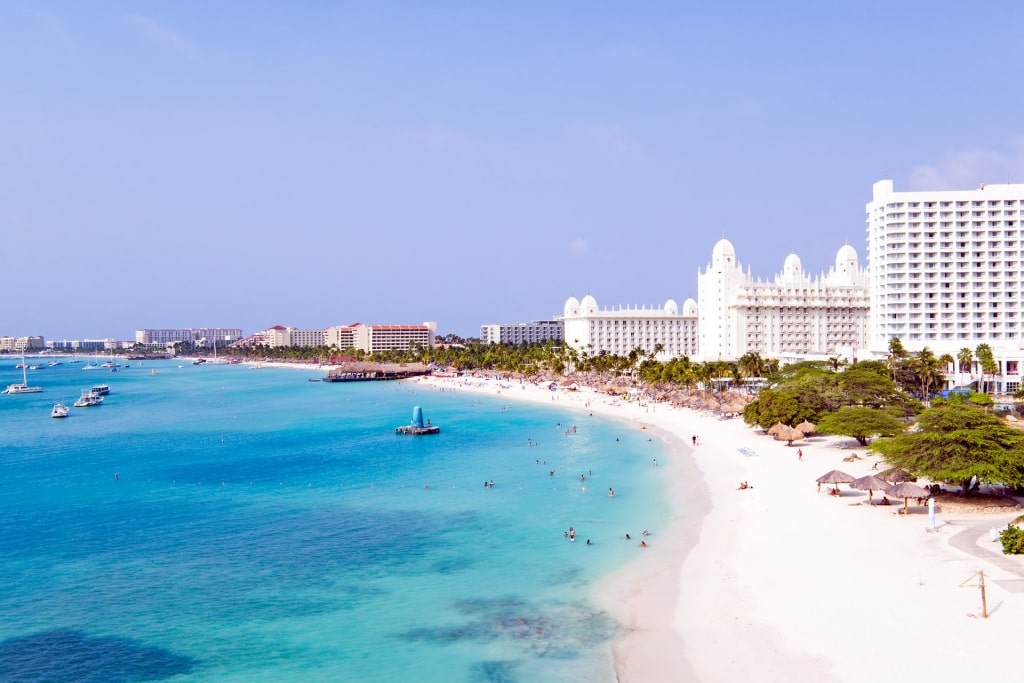
Palm Beach, Aruba
Aruba is one of the most beautiful islands in the world. Perhaps that’s why locals and visitors alike use the same slogan when describing it: One Happy Island. Some of the happiest people on the island are Aruba’s surfers, who have their choice of spots to catch a wave.
One of the best beaches in Aruba for surfing is Palm Beach, a fantastic spot for beginner surfers. There are several surf and paddle shops along the two-mile stretch, so you’ll have plenty of options for rentals or lessons. Though the sandy shores are mostly undeveloped, you’ll find everything from boat tour companies to laid-back cocktail bars and award-winning restaurants just across the street.
At Palm Beach, surfers can expect one- to two-foot waves on most days, though they could be a little bigger in the winter when swells are larger. The water is usually warm, though you might want to rent a wetsuit from an area shop if you’re spending all day in the water.
St. Thomas, U.S. Virgin Islands
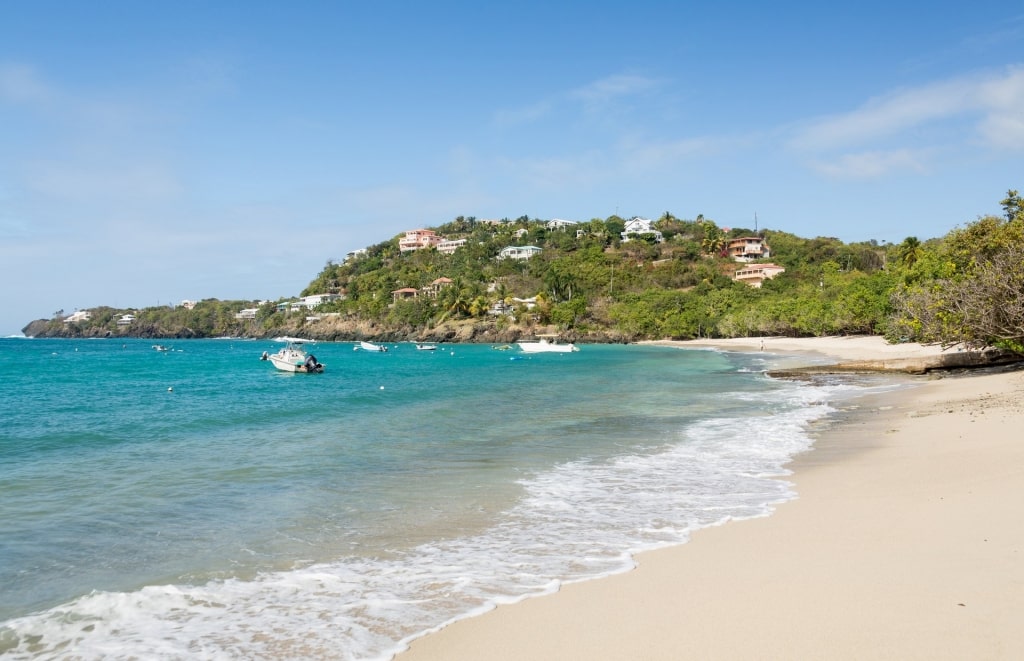
Hull Bay Beach, St. Thomas
You can’t talk about surfing in the Caribbean without mentioning St. Thomas and, specifically, Hull Bay Beach. You can almost always count on finding surfable small to medium waves here, with very obvious surf breaks. It’s best for people who have stood on a board before or are at least strong swimmers since the surf breaks tend to be a bit far offshore—prepare for a lot of paddling.
Hull Bay is an uncrowded stretch of sand with basic beach facilities and a handful of restaurants. You’ll likely be paddling out next to people who have been here plenty of times at this local’s beach.
Keep in mind that the bottom is rocky in places, so you may want to wear water shoes. The flip side of that is that the rocks create a perfect habitat for fish and sea creatures, offering some of the best snorkeling in the Caribbean in case you want to take a break from surfing.
Antigua

Half Moon Bay, Antigua
Antigua may not be as well known as islands like Aruba or Barbados, but the island is home to some of the best surfing in the Caribbean—as well as some of the best kitesurfing, windsurfing, boogie boarding, and bodyboarding, too.
If you’re anxious to catch a wave, head to Half Moon Bay, one of the best beaches in Antigua. It’s on the island’s eastern (windward) side, so the waves and currents are consistent. Though Half Moon Bay is the most famous bay in the area, the nearby shoreline is dotted with bays in both directions, so there are plenty of places to surf. Some of the bays have steep drop-offs that create larger waves, while some have natural rock barriers that keep the waves small and slow.
Consider stopping by one of the many surf shops in the St. John’s area to explore your options for lessons. Almost all shops include transportation as part of the class, and the shop pros will know exactly where to take you for the perfect waves on any given day.
Puerto Rico

Condado Beach, Puerto Rico
If you’re interested in surfing in the Caribbean, Puerto Rico is a top destination to consider. San Juan serves as a good starting point while you’re exploring different Puerto Rican beaches, as many of the top surf spots are between an hour and a half to two hours away.
Condado Beach is the closest surf spot to town and is a good option for more experienced surfers. The waves aren’t as consistent as those you’ll find on the west coast of Puerto Rico, but it’s still worth it if you’re short on time and want to explore the city while still catching a few waves.
Those new to surfing will find some of the best beginner waves at La Pared in Luquillo, about a 45-minute drive outside of San Juan. Its consistent waves and sandy ocean floor create ideal conditions for learning the basics. For more 1:1 direction, sign up for a private surf class or join a group lesson.

Aguadilla, Puerto Rico
Intermediate and advanced surfers also head to Aguadilla, located northwest of San Juan. The waves here are powerful and can be a challenge for many surfers. The beach isn’t super touristy which can be a plus, but there are still several surf schools offering lessons and places to rent a board.
A bit farther west is Rincón, which is arguably the most famous surf town in Puerto Rico. Waves here are most consistent from October to April, and this is also when more intermediate and experienced surfers come to the island. When you’re finished surfing, spend some time exploring the town. There are lots of surf shops, surf schools, and beachside bars to check out.
Dominican Republic
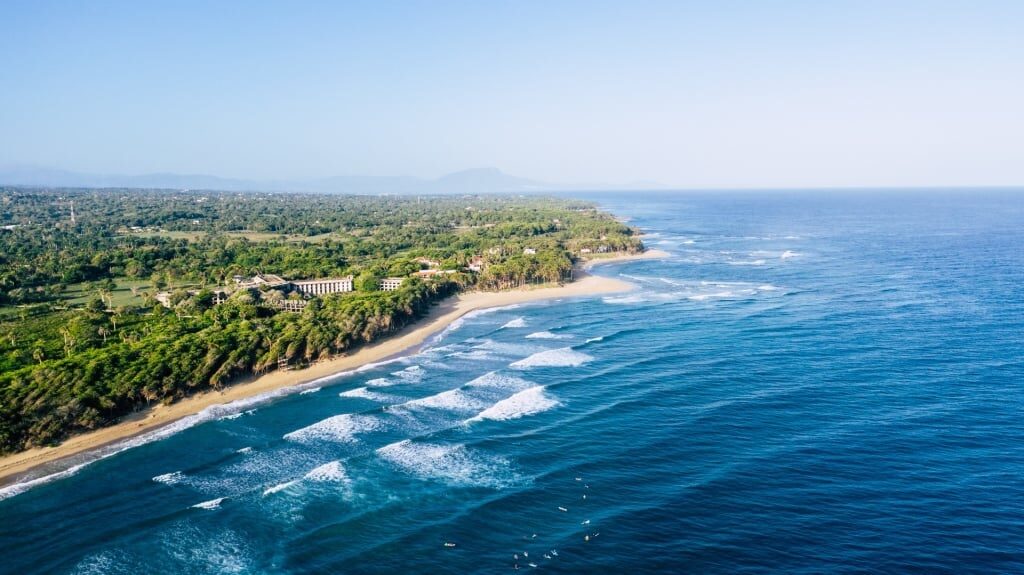
Playa Encuentro, Dominican Republic
The Dominican Republic is easily one of the Caribbean’s premier surf destinations. The only catch is that some days are windier than others, which can affect both the shape of the waves and how easy they are to catch. The best wind conditions are light, offshore winds that blow from the land toward the sea.
Playa Encuentro, just over an hour’s drive east of Puerto Plata, is the go-to starting point for surfers of all levels. It’s the main surf spot in Cabarete and offers everything from mellow waves for beginners to more powerful reef breaks for experienced surfers. Waves are at their most consistent from October through April. However, you can find smaller waves even during the summer season.

Cabarete Beach, Dominican Republic
Closer to the heart of town is Cabarete Beach, one of the best beaches in the Dominican Republic, offering a mix of breaks for all skill levels. Weather and wind conditions can change quickly, so they play a big role in how many waves you’ll catch.
Surfers can sign up for a beginner lesson or rent a board for the day. As with other popular surf areas, it’s important to be mindful of your fellow surfers and avoid going for a wave that someone else is already chasing.
Jamaica
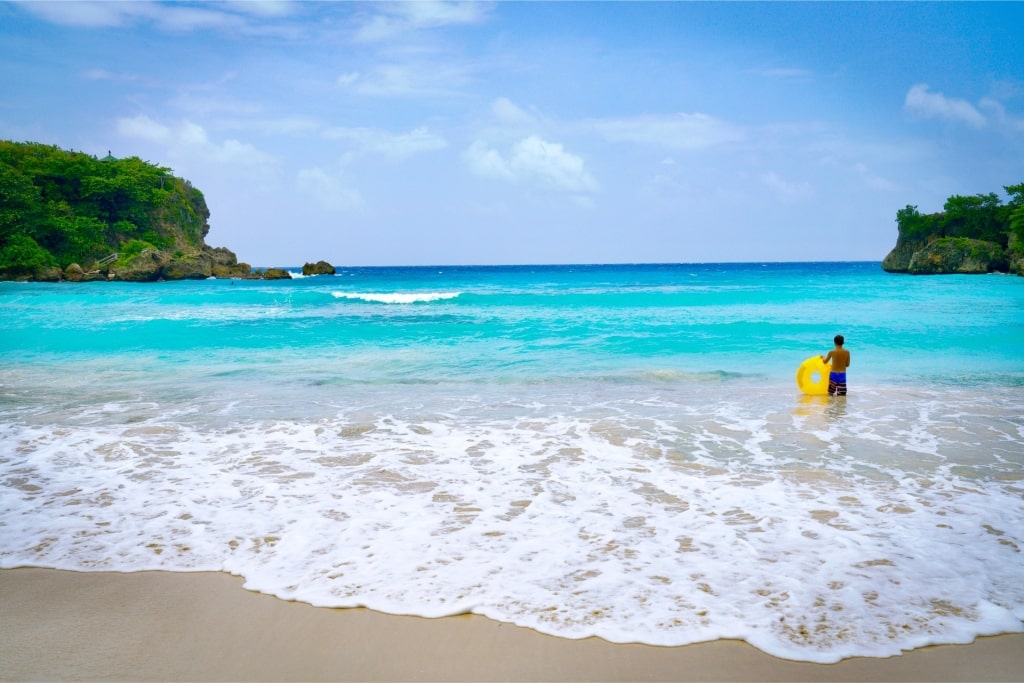
Jamaica
Jamaica may be best known for its laid-back island vibes, but the surf scene here is actually pretty big. Warm water, consistent waves, and a variety of surf schools make Jamaica a great place to take beginner classes.
About a two-hours from Ocho Rios, you’ll find two surf spots to explore: Lighthouse Beach and Makka Beach. The waves at Lighthouse Beach are more beginner-friendly, while Makka Beach is ideal for surfers with more experience under their belt. Surf schools are available at both beaches if you want more 1:1 attention.
Martinique

Le Lorrain, Martinique
Surfing in Martinique isn’t as popular as, say, Barbados or Puerto Rico, but this can have its upsides. Fewer crowds mean there’s less competition for waves, and—for beginners—more chances to practice getting up on your board.
Starting with the best-known surf spot on the island, Anse Bonneville is located on the Caravelle Peninsula but is positioned closer to the Atlantic Ocean. Winter gets you the best waves, with many waves reaching several feet high.
For something a bit calmer and more intermediate-friendly, head to Le Lorrain. Waves are usually a foot or two smaller than in other spots around the island, making it more suitable for beginner surfers or those with a moderate skill level.
Dominica
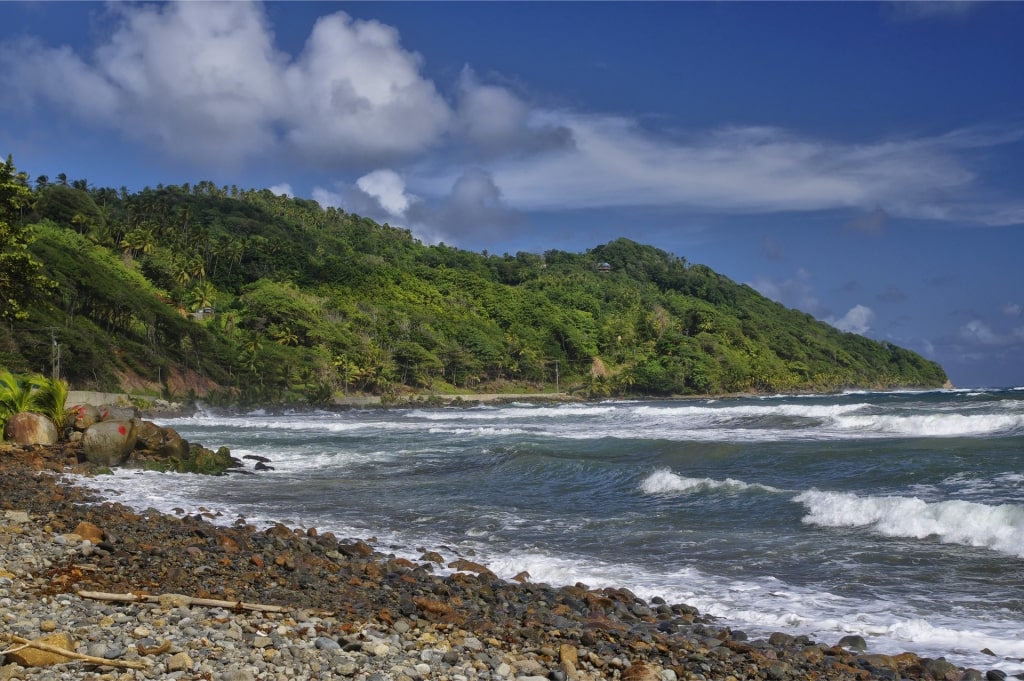
Pagua Bay, Dominica
Surfing in Dominica is a year-round pastime, but the best months are from September to January, as waves are most reliable during this time. Winter brings stronger swells better suited to experienced surfers, while smaller summer waves are less intense and more beginner-friendly.
Most surf spots in Dominica are located on the island’s northeast coast. About an hour’s drive from Roseau is Pagua Bay, one of the more surfable areas on the island. The bay faces the Atlantic Ocean, which means the swells are pretty strong, especially in winter. It’s a quiet, mostly undeveloped area, best for intermediate surfers.
Also on Dominica’s northeast coast, Hampstead Beach is another notable surf spot. Facing the Atlantic, it gets decent swell from November to March and occasionally during the shoulder seasons. Due to the strong currents that are common in Dominica, only intermediate and advanced surfers should tackle these waves.
St. Lucia
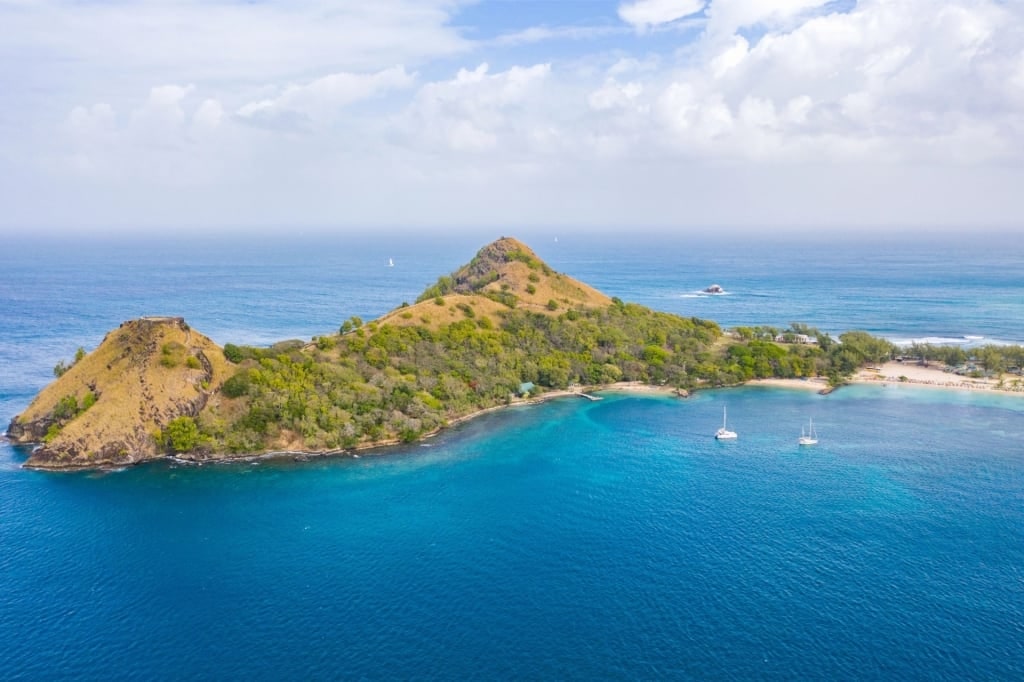
Pigeon Island, St. Lucia
Surfing might not be the first thing that comes to mind when thinking of St. Lucia, but there are actually quite a few great spots to explore. Surfing in St. Lucia is generally best for intermediate riders, as beginners might find the waves a little tricky to learn on, while advanced surfers might not feel challenged enough.
Pigeon Point is one of the most popular places to surf in St. Lucia, partly because it offers a reef break on both left- and right-hand waves. Waves are best during mid to high tide, and the main thing surfers should be cautious of is the rocky reef bottom and the occasional sea urchin. Even if you’re not a surfer yourself, it can still be fun to go there to watch others riding the waves.

Marigot Bay, St. Lucia
Located just south of Castries, Marigot Bay is another surf spot worth exploring, especially for experienced surfers who can handle the fast waves. The best time to go is at mid to high tide, and similar to Pigeon Point, it’s smart to keep an eye out for urchins and rocks in the area.
Grenada
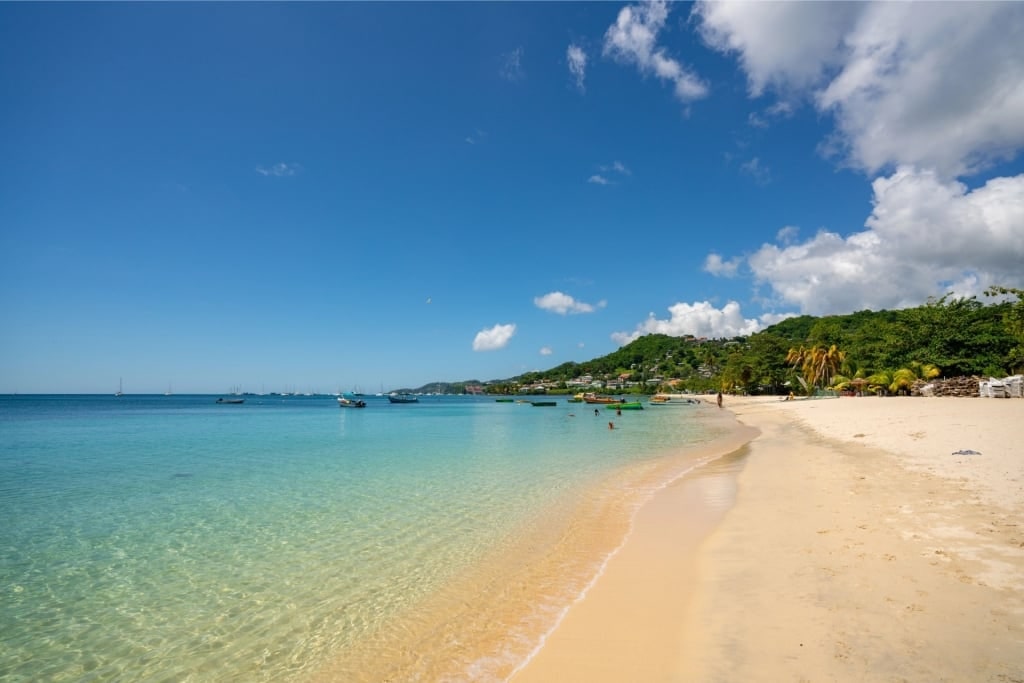
Grand Anse Beach, Grenada
Grenada isn’t a surf destination per se, but there are a few great places near St. George’s to catch some waves. As with other Caribbean destinations, the best months for surfing in Grenada are from November to April, give or take a few weeks on either end.
Prickly Bay is a solid place to start, as it’s close to St. George’s and offers a consistent point break. Waves are on the larger side, many of which reach anywhere from three to six feet high. Since the water here is shallow and coral heads can appear above the surface at low tide, it’s important to stay alert as you ride the wave.
On the east coast of Grenada is Cherry Hill. While Prickly Bay has a left-hand point break, Cherry Hill offers a right-hand break. The waves are less reliable than at Prickly Bay, but it’s a popular surf spot all the same.
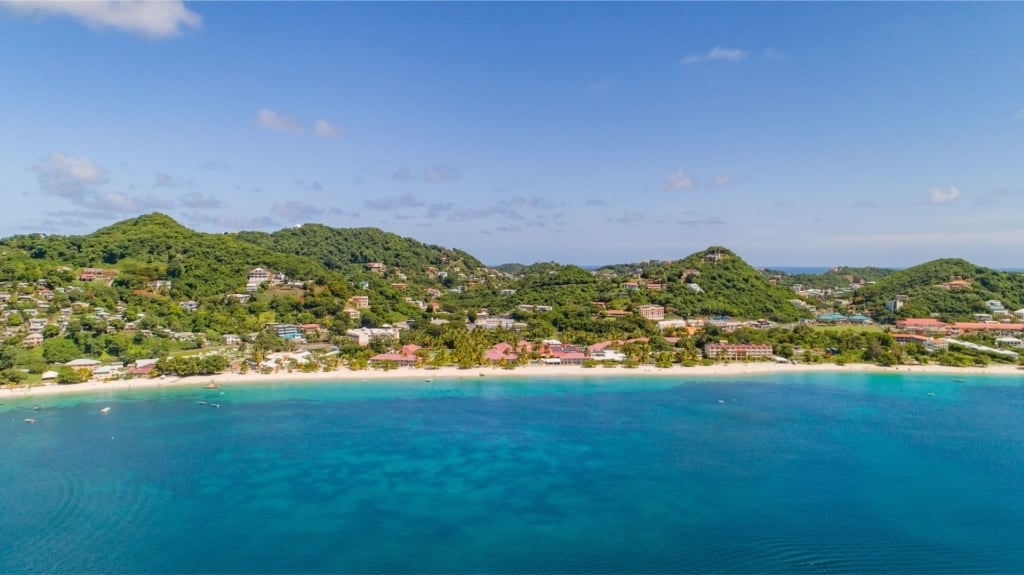
Grand Anse Beach, Grenada
If you’re traveling with a friend or group who doesn’t surf but still wants to get in on the fun, consider heading to Grand Anse Beach, one of Grenada’s best beaches. The waves here are small and better suited for longboarders. Stand-up paddleboarding is also a popular option, thanks to the calm waters.
FAQs
Which Caribbean island has the best surfing?
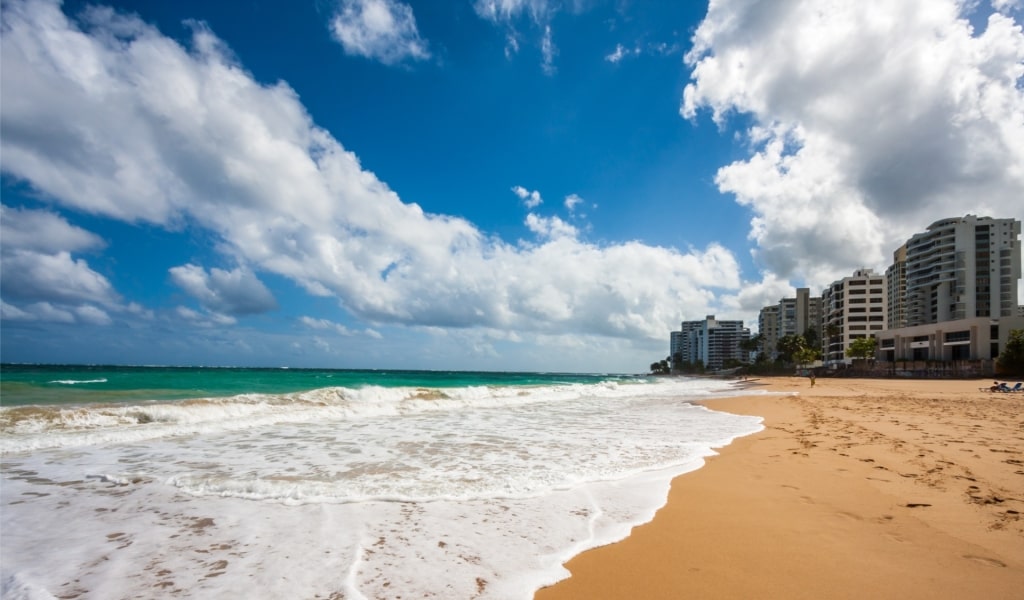
Puerto Rico
There are so many great surfing spots in the Caribbean that choosing the “best” one will yield different answers.
In general, many travelers agree that Puerto Rico is one of the top surfing destinations in the Caribbean. The waves are consistent, and there are plenty of different spots to explore. If time permits, consider heading to the Rincón area, about a two-hour drive from San Juan. There you’ll find several different breaks for all skill levels.
Surfers can find other popular spots in Barbados, the Dominican Republic, as well as other islands.
When is the best time to surf in the Caribbean?

Bathsheba Beach, Barbados
While there’s no wrong time to surf in the Caribbean, the winter season is definitely considered the most optimal.
From November to March is prime surf season for much of the region. During these months, the islands get cold fronts from the Atlantic Ocean that generate consistent swells. This is especially true for surf spots in Puerto Rico, Barbados, and the Dominican Republic. The waves in these places can get pretty big and are always a hit with seasoned surfers or those ready to level up their skills.
If you’re a beginner surfer and fine with smaller or less reliable waves, there’s no harm in visiting the Caribbean outside of peak surf season.
Where can beginners surf in the Caribbean?

Encuentro Beach, Dominican Republic
For beginner surfers, the Caribbean can be a great place to learn or develop your skills. There are plenty of beginner-friendly surf spots and instructors available to help you make the most of your lesson.
In the Dominican Republic, Encuentro Beach near Cabarete is one of the top spots for beginners, with soft breaks and several surf schools to choose from. Over in Puerto Rico, La Pared in Luquillo offers gentle waves that are ideal for learning the basics, while Freights Bay in Barbados is another great option for first-timers.
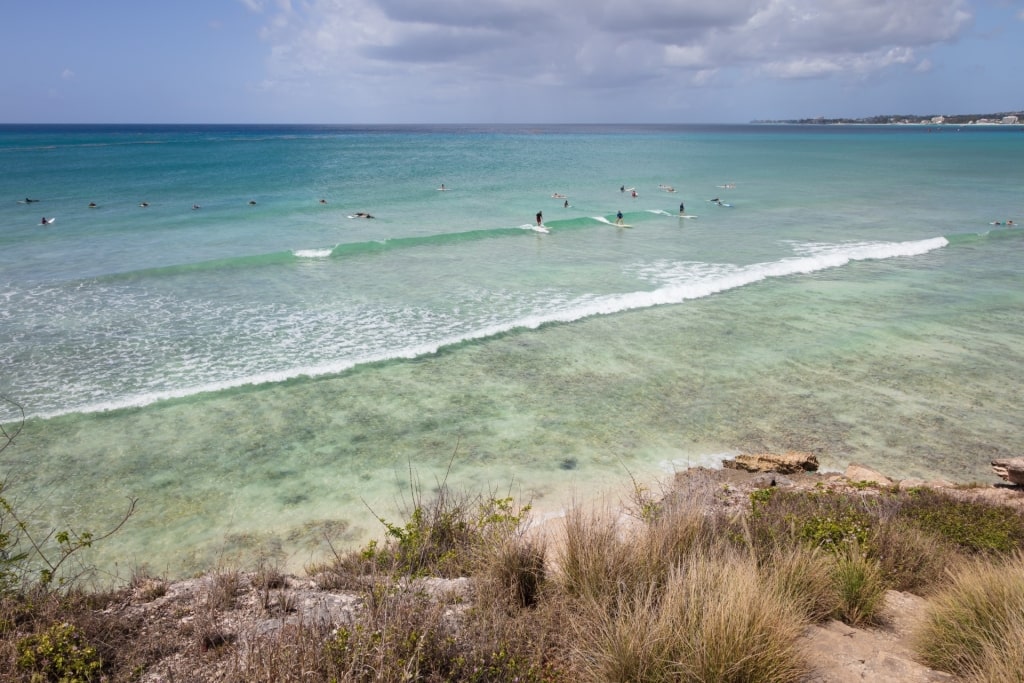
Freights Bay, Barbados
That said, most destinations in the Caribbean have at least one beach that’s beginner-friendly. When booking a lesson, make sure to mention that you’re new to surfing and prefer the calmest conditions possible. The waves might not always be exactly what you expected, but instructors do their best to make sure you’re comfortable.
Do I need a wetsuit?
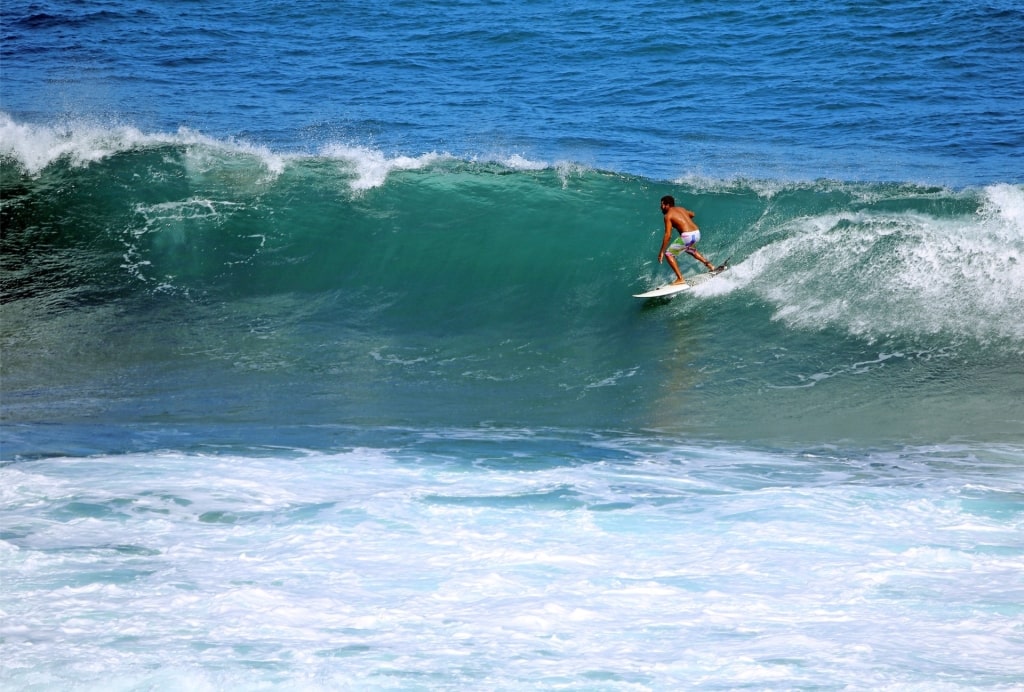
Bathsheba Beach, Barbados
Whether or not you wear a wetsuit for surfing in the Caribbean ultimately comes down to personal preference, but the vast majority of surfers go without one. Water temperatures typically range from 78°F to 84°F year-round.
If a wetsuit feels too bulky but you’d still prefer some coverage, consider packing a thin spring suit. For the most part, though, you’ll see surfers completely comfortable in board shorts or a swimsuit. Bringing a rash guard for sun protection is also helpful, for both your skin and the reef.
Are there reef breaks or beach breaks in the Caribbean?
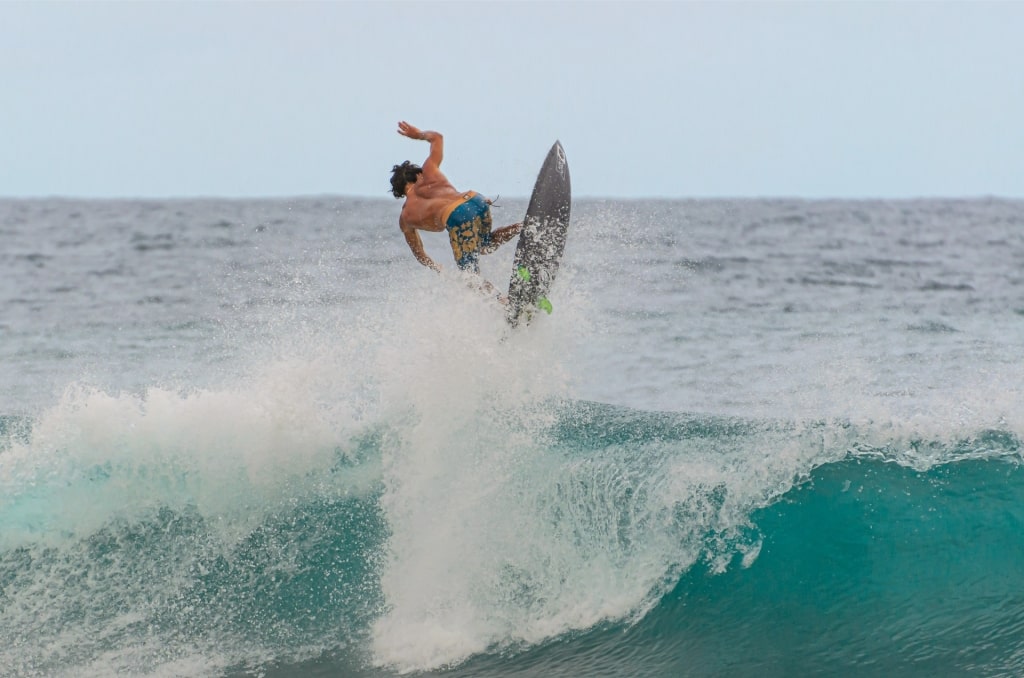
Surfing in Puerto Rico
In surfing terms, reef breaks and beach breaks refer to the type of seabed that the wave breaks over. Reef breaks occur when waves crash over a coral reef or rocky seabed. These waves tend to be more powerful, but they can also be more dangerous. Beach breaks, on the other hand, occur over sandy seabeds and can be more variable in wave size and shape.
You’ll find both reef and beach breaks throughout the Caribbean. Reef breaks are more common in places like Barbados, Puerto Rico, and the Dominican Republic. These waves are usually clean and strong, but skilled surfers should still be careful, especially in shallow areas.
Beach breaks are less common in the Caribbean but do exist. Crash Boat Beach in Puerto Rico is a good example, as are some spots around Cabarete. If you’re new to beach breaks, consider going out with a surf instructor or local guide.
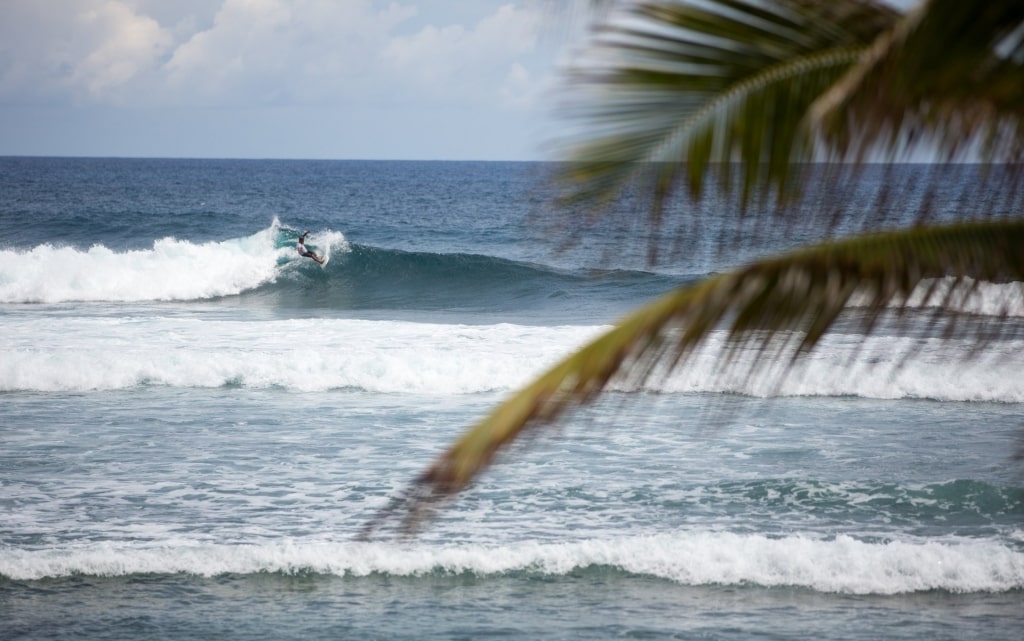
Bathsheba Beach, Barbados
When it comes to surfing, the most important thing is to have a good attitude and come prepared to endure a few falls. Fortunately, when you’re surfing in the Caribbean, those falls are in warm, sparkling blue water.
On a cruise to the Caribbean, spend your days in port surfing and your nights sailing while indulging in globally inspired dining, luxurious accommodations, and thrilling live performances. Visit our website to book your next tropical vacation.
